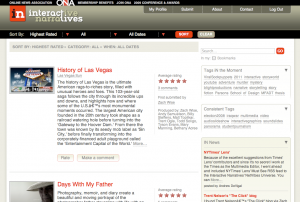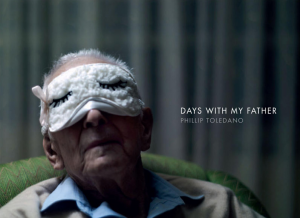By Melanie Gibson
Being a convergence journalism major at Mizzou, I’ve learned a fair amount about the importance of multimedia storytelling. To be honest, it’s gotten to the point that I can’t think that a story is complete with out a visual component, text and some form of audio component to really tell a story. Because that’s what we want to do – as journalists, we want to tell stories that are as rich in content and context as the individuals that we interview. And sometimes, the stories we find are far too big and rich to be contained in 1:30 radio news piece, a photo and text. This is where the documentary-style of reporting comes in. The documentary gives the reporters and producers a more time and space to be creative and tell the story, but the documentary is out and the online interactive narrative is in. This form of storytelling brings the documentary online to a wider audience and lets them interact with the story material.
If you are looking for examples of this form of storytelling, look no further than interactivenarratives.org. ONA sponsors the site, which showcases interactive and nonlinear multimedia stories on the web and allows users to rate the stories and interact with them as well.
The stories featured on the site range from a heart-wrenching pictorial account of a son about his father’s last days, to the Guardian’s piece about a brass band of orphans in the Congo to a choose-your-own-adventure news game like Prison Valley. The range of stories is both wide and deep, but something they all have in common is how they evoke the user’s emotion in a way that is difficult to do in a traditional piece of print journalism.
Phillip Toledano’s account of days spent with the elderly father, who has short-term memory loss, after his mother passes away until his fathers passing is both beautiful and touching. While it’s difficult to argue that a first hand account of your father is truly journalism, it does tell a very touching story and is quite visually interesting. The format of the site is like a slide show in that you can only see one thing at a time. As opposed to the user experience in Prison Valley, the creator is in control of what the user sees.
The Guardian’s Bright Brass is a collection of videos that can sand alone, but are group in such a way that the user comes away with a deeper understanding of what life is like for street children in the Congo. The visuals are stunning and hearing the children talk about their past and how they came to be in this band evokes a lot of emotion.
Before the user can enter the game, they are given the option to interact with other using the game via Facebook and Twitter.
Prison Valley starts off with a narrative account of residents of Canon City, Colo., talking about their town and why it’s called Prison Valley and then another intro into the game where the user is introduced to why this town is referred to as the “clean version of hell” where “everyone on the outside, is inside.” After this intro the news game aspect begins and the user picks their adventure, so to speak. By clicking on different menu options on the screen the user will view different material and learn different things about the community. Within the game, the user can even register and get plugged into the game through Facebook and Twitter. So not only is the user interacting with the game, the user can interact with others who are also in the game as well. Even though Prison Valley is a game, there is still a lot of reporting and good journalism that went into making the product.
So where do you think the future of long form multimedia journalism is going online? Will it be gathered and group in traditional news websites like the Guardian or will it be fashioned into something centered upon user interaction and experience like Prison Valley? Let us know in the comments below.





No comments:
Post a Comment